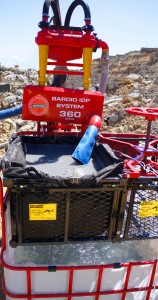New solids control technology brings ‘pitless’ drilling to wireline coring operations
By Katie Mazerov, contributing editor

Halliburton’s Baroid Industrial Drilling Products division is seeing global deployment of its solids control technology for processing waste in continuous wireline coring operations, eliminating the need for earthen pits or sumps to capture solids and fine cuttings. The “pitless” drilling process, SYSTEM 360, uses a combination of mechanical and chemical separation technologies to extend the life of the drilling fluid by recapturing up to 80% of the original water content from the waste stream, thereby reducing overall water usage.
The system completely removes fine, problematic cuttings from a fraction of the total drilling fluid volume and maintains the desired mud density, explained Bob Brown, Baroid’s global business development manager. “This is a very specific solution aimed at a sector of the industry that has not been served by conventional solids control technology, such as shale shakers,” he said. “Until now, wireline coring operations have depended on large pits to process solids and cuttings, a method that is expensive and inefficient because of the length of time it takes for ultra-fine cuttings to gravity-settle. With this new system, we can reuse the water and run lower-solids mud, which results in higher production rates during the drilling process.”
In addition to improved drilling performance, contractors are seeing improved borehole stability resulting in reduced re-drills and increased rates of penetration, and a more stable water supply for continuous drilling. “Operators are enjoying significant reductions in water usage, reduced truck time in bringing water to and removing waste from the drill site, and improved safety by eliminating haul-road traffic and the cost of digging and rehabilitating ground pits.”
The system involves three key steps:
- Drilling fluid from the sump is pumped through hydrocyclones that separate beneficial solids from non-beneficial solids. Usable drilling fluid is returned to the system;
- A chemical flocculation process reduces the waste stream that the hydrocyclones create. Clear water is separated from the flocculated solids into a collection tank for reuse; and
- The flocculated dried material is compacted into a bag for disposal. The reclaimed water from the treated fraction is used to mix additional drilling fluid.
SYSTEM 360 – so named because the drilling fluid moves full circle from the original make-up water to the separation of drilling solids in a dried and bagged form to the eventual reuse of the drilling fluid – was introduced in December 2011. Since then, units have been installed in Peru, Chile and several other Latin American countries, as well as the US, Canada and Australia, where field trials have been completed in coal seam gas (CSG) exploration operations up to 1,000 meters deep.
“The system’s environmental benefits have ensured landholders that exploratory drilling is safe,” said Andrew Bilton, Baroid’s field service representative in Australia. “SYSTEM 360 lets us show landholders how we take the drilling fluid out of the ground and put it into surface tanks, reducing the impact on the land and potential danger to livestock.”





I would like to hear more about your process.